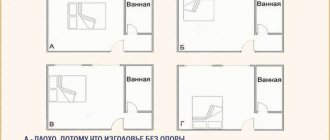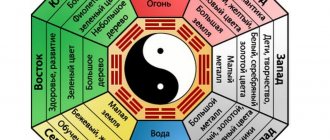You do everything to be rich: you earn money, you save money, you invest money. But there are still not enough funds?
Where is the wealth zone in your premises? What part of your home and office is responsible for the flow of money?
If the answer is “I don’t know,” then you are probably not doing the most important thing, without which it is impossible to be rich - do not strive for internal and external harmony.
This article provides recommendations for landscaping the wealth zone according to Feng Shui and Vastu Shastra.
Which of the ancient teachings should you give preference to? Whatever you like best. If you want, apply all the acquired knowledge at once! There is not much difference between them, much less contradictions.
WHAT IS THE DIFFERENCE between FENG SHUI and VASTU?
Olga Marta Lesnaya
WHAT IS THE DIFFERENCE between FENG SHUI and VASTU?
The main difference between Vastu and Feng Shui is that Vastu is based on a theistic perception of the world, i.e. on the assertion that the Creator (God) exists, and the basis of Feng Shui is “nirvishesha” - emptiness, nothingness, the concept of the non-existence of God.
The second difference between Vastu and Feng Shui is that Vastu considers four levels: physical, karmic, energetic and spiritual. Feng Shui works exclusively on the physical level, slightly affecting the energy level.
According to Vastu, the physical level consists of five basic elements from which our entire Universe is “built” - air, earth, water, fire and ether.
The energy level is the influence of the nine “grahas” (planets in Sanskrit) on a person and on the space in which a person is located.
The karmic level considers the influence of the rulers of the eight main directions of light on people and on the premises they occupy.
The fourth, spiritual level considers the influence of Avatars - the various incarnations of God. Their influence is strongest in the eight main cardinal directions.
There is another significant difference between Vastu and Feng Shui: applying the laws of Vastu in practice always leads to positive results.
Feng Shui also does not harm, and sometimes helps, but the results of using Vastu are much stronger and more noticeable on all four levels.
How to achieve good Vastu in your home?
Five tips for getting positive Vastu at your home:
1. Do not keep any junk in the northeast sector of your home. This sector is considered one of the most important in Vastu. This place is sacred because it is ruled by Jupiter, the guru of all demigods. It must be kept clean at all times. If the toilet in your house is located in the northeast, this has a very negative effect on the entire energy of the house.
2. Never clutter the space at the main entrance with trash. The main entrance to a house or apartment is the mouth of your house, through which the entire house receives prana, or Chi in Feng Shui, i.e. vital energy. The most unfavorable position of the main entrance to the house is the southwest, because it is from the southwest that the negative influence of the planet Rahu comes.
3. The kitchen is a sacred place in the home. The quality of the kitchen affects the quality of life of the entire house and all its residents. “We are what we eat.” People in good health and long-lived people tend to eat well. Keep the kitchen clean, do not allow pets in the kitchen, do not wear dirty, unkempt clothes, and do not eat in the kitchen.
4. The central part of your home - the Brahma stana - should be open, bright and free of furniture. A kitchen or toilet located in the central part of the house will greatly degrade the energy of your home. This is because the main chakras of Vastu Purusha, the symbol of living space in Vastu, will be blocked.
5. It is very important where your head is directed during sleep. The most unfavorable direction is north (legs are stretched to the south), in which case a person’s sleep can be shallow, intermittent, a person gets up in the morning not rested and full of strength, but broken and tired.
Directing the sleeper's head to the east helps to better master knowledge, learn and remember better; to the southeast - brings material wealth and the ability to study better; to the south - material well-being; to the southwest - material well-being and popularity; to the west - popularity; northeast and northwest are considered neutral directions.
These five factors are very important in Vastu, but this is only a small part of this science. There are more than 150 different aspects of Vastu, which can be both positive and negative.
✔According to Vastu, the master bedroom should be in the southwest corner of the house. If the house has more than one floor, then the master bedroom should be on the top floor.
✔ The children's room must be in
northwest corner.
✔The bathroom can be located in any sector except the southwest and southeast. A toilet should never be placed in the northeast.
✔The living room should be located in the northwest, as well as in the south or west.
✔The north-eastern sector in the apartment should be as open as possible.
✔The kitchen should be located in the fire sector, i.e. in the southeast. The cook should face east. The sink is in the northeast corner, the refrigerator is in the northwest. The trash can should always be closed and located in the southwest corner.
✔Northeast, northwest, north, west, east sectors are the best for study room. If this room has an adjacent wall to the puja room, it is considered most auspicious.
✔The best place for a pantry is the southern sector.
✔The guest room should be in the northwestern sector. In the same sector you can have a room for girls.
✔Entrance doors should be in the north or east and should be larger than the interior doors. All doors must open inward.
✔Rooms in the northern part of the house should be larger than rooms in the southern part and 15-25 centimeters lower. The ideal room height is 3.6 - 4.2 m.
Birth Star Rule
Birth Star
is the combination at the moment of birth that determines the ruling nature of a person. To determine the birth star, you need to know the exact time and place of birth of a person. This birth star determines its frequency or vibration for everyone, and it is called Nakshatra. More details about this are written in the article Vastu and Jyotish. When designing a house according to Vastu, the architect calculates the dimensions of the structure in such a way that the house vibrates harmoniously with the earthly and cosmic structure, as well as with the birth stars of the owners of the house. These calculations are called Ayyadi calculations. Ayyadi calculations must necessarily be carried out in the design of a house according to Vastu so that the structure of the building has a nutritional effect on the residents. To maintain vitality and health, each person needs to be in resonance with the Universal Energy of the Universe. When resonance is disrupted, a person is susceptible to illness and stress. The structure of the house, made according to Vastu, creates an environment where a person is enveloped in nourishing positive vibrations. The home becomes extremely peaceful, which benefits the mind and heart.
From Gulyai-Polye to Butyrka
Nestor Makhno became acquainted with anarchism at the age of sixteen, joining the “Peasant Group of Anarcho-Communists” (this circle was also known as the “Union of Free Grain Growers”), operating in his native village of Gulyaypole. By this time, Makhno had a half-starved childhood and early work experience behind him, so he burned with uncontrived hatred for the exploiters. The period between the first Russian revolution and the February Revolution was the heyday of Russian anarchism, and sixteen-year-old Nestor actively participated in all the circle's operations, mainly related to expropriations. This brought him to prison: two detentions ended in release, but the third time, for the murder of a military official, he and sixteen comrades were sentenced to hanging in 1910, which, due to his youth, was replaced with indefinite hard labor. True, Makhno never got there: he spent almost seven years in Butyrka prison in Moscow and was released after the February Revolution.
"Peasant group of anarcho-communists" of Gulyai-Polye in 1907. First on the left in the first row is 19-year-old Nestor Makhno
Source: commons.wiki.org
Rule of harmonious color
In Vastu design, color combinations play an important role in the harmony of space. The colors in the interior according to Vastu should be selected in harmony by a professional specialist. The best colors according to Vastu that should be used indoors to create a favorable, peaceful space are those colors that are found in the natural environment, in conditions of clear skies and bright sun. You should not use dark, “dirty” colors in a large mass, since in conditions of limited illumination of the space, this can have a “pressure” effect on the human psyche. Good colors to use on walls include creamy white, light yellow, light blue, light green and light pink. It is worth noting that the influence of color according to Vastu is mostly subtle. However, this is important when all the principles of Vastu are applied as fully as possible in the building.
How Father Makhno met Lenin
Nestor Makhno’s return to his homeland was, if not triumphant, then very joyful: revolutionary romance had not yet given way to bitterness, and his fellow countryman, who escaped from prison, was greeted with honor in Gulyai-Polye. Makhno immediately became involved in political life, trying with all his might to put into practice the knowledge and ideas about anarchism that he received in his prison cell from his fellow prisoners. After the beginning of the German occupation of Ukraine, Makhno, together with the remnants of his fighting squad “Black Guard”, retreated to the territory of the RSFSR, after which he decided to get a more detailed idea of the system that was created on the territory of this republic. It was within the framework of this political tour that the future leader of the peasant army met in 1918 with the Chairman of the Council of People's Commissars, Vladimir Lenin, after which he returned to his homeland to begin the revolutionary struggle.
Nestor Makhno in 1918 during the formation of the rebel army after returning from Soviet Russia
Source: commons.wiki.org
Favorable land rule
A favorable plot of land is the basis for a future harmonious home according to Vastu. The rule for selecting a favorable site is based on many components, such as slopes on the site, nearby bodies of water, the location of roads around the site, trees on and around the site, proximity to churches and other buildings, the quality of the soil on the site and many others. More information about a favorable site is written in the article site according to Vastu. An important rule in creating harmony on a site is, in addition to its location in the environment, the orientation of the boundaries and the shape of the territory. Also an important factor is the location of the entrance to the site. There are many factors for a favorable site according to Vastu for building a harmonious house on it that will resonate with the environment and the subtle energy of the universe. It is advisable that a good site for construction is selected in advance before designing a house on it according to Vastu. Our studio offers a service for selecting a harmonious site, in which a specialist will take into account all your requirements and the positive aspects of Vastu in order to select the right site for the construction of your ideal home.
Beat whites always, and beat reds when necessary
Surprisingly, Nestor Makhno’s active revolutionary and military activities lasted only three years - from 1918 to 1921. But during this time, he managed not only to create a real partisan army and develop a classic partisan strategy (many elements of which were used by Soviet partisans two and a half decades later), but also to fight on the side of the Bolsheviks. Makhno entered into an alliance with them twice: in 1919, his army became part of the 1st Trans-Dnieper Soviet Ukrainian Division of the Ukrainian Front, and in 1920, a detachment of Makhnovists participated in the liberation of Crimea from the Wrangelites. But both times Makhno himself and his comrades quickly broke off relations with the Red Army. And both times - after the Bolsheviks tried to extend their regular rules to the anarchist freemen. However, Makhno fought consistently and unconditionally with the Whites: neither Anton Denikin nor Peter Wrangel managed to agree with his army on joint military operations. Moreover, in all his appeals Makhno called the Bolsheviks temporary allies and the Whites ideological opponents.
Commander of the 1st Trans-Dnieper Ukrainian Soviet Division Pavel Dybenko and commander of the 3rd Trans-Dnieper Brigade Nestor Makhno, late 1918
Source: commons.wiki.org
New construction
If, nevertheless, you are very concerned about the problems and incorrect rules of Vastu that are present in your apartment or house, then you should find the strength and opportunity for new construction. If you can afford it, then implement for yourself a comprehensive Vastu structure for complete peace, harmony and prosperity in life. Only fully adhered to Vastu rules in home design will help bring peace, prosperity and happiness into your life. However, it is worth remembering that a house made according to Vastu rules is only a place that has a harmonious resonance between the structure of the cosmos, the Earth and the human structure. This harmonious place can bring enlightenment to the heart and mind. But the main driving and changeable force remains the person who is on the path to positive changes in his life. And a house according to Vastu can only help a person who follows the cosmic order and is tuned to resonance with harmonious vibrations.
Brigade commander with two classes of education
The highest official military rank of Nestor Makhno was the rank of brigade commander, received in 1919, when his army became part of the Ukrainian Front as the 3rd Trans-Dnieper Brigade. In the anarchic peasant republic created by Makhno on the territory of his native Gulyai-Polye and adjacent districts of the Yekaterinoslav province, he was simply called “father.” However, he never received any systematic education, especially military education. As a child, Makhno managed to graduate from two classes of the zemstvo school; later, in the Butyrka prison, he expanded his horizons, studying mathematics and history under the guidance of the anarchist Pyotr Arshinov. But all this did not prevent the leader of the peasant freemen from proving himself to be an excellent tactician, whose abilities, not without discontent, but fairly, were recognized by both Lieutenant General Anton Denikin and Army Commander Mikhail Frunze. Suffice it to say that in the summer of 1919, the breakthrough of Makhno’s army from the encirclement of Denikin’s troops and the raid on their rear largely predetermined the failure of Denikin’s attack on Moscow, and at the end of 1920, Red Army formations suffered a failure in an attempt to destroy the main forces of Makhno’s army, which Army Commander Frunze called “ St. Andrew's embarrassment."
Nestor Makhno with his wife Galina Kuzmenko surrounded by his associates, Poland, 1922
Source: commons.wiki.org
Energy grid rule
The most important rule in the science of Vastu is the rule of the energy grid. A network of energy lines covers the globe. We know these lines as the magnetic grid on the surface of the Earth, latitude and longitude. The entire planet pulsates with life and radiates its energy through this grid system. The energy grid rule states that the house structure plan should also be divided into a grid of squares or rectangles. Then the house plan will be exactly above the earth's energy grid. This establishes a kind of geometric harmony with the earth's grid. Then the constructed space and the space of the planet resonate harmoniously with each other. Vastu says that a person is constantly exposed to the energy of the Earth. And to be in harmony with the energy of the planet is the goal of Vastu science. In the human heart resides an atom of divine energy through which we can vibrate with life. The earth also vibrates from within, sending out energy waves. The Vastu designer creates harmony by implementing the energy grid rule and mathematically calculating the harmonious perimeter using Ayadi.
Deadly legacy from Butyrka
Despite all his talent as a tactician and partisan, Nestor Makhno was ultimately defeated by the Red Army and was forced with a small detachment of associates to leave for Romania. The Romanian government refused the demand to extradite him to Soviet Russia, but did not want to keep the dangerous rebel, organizing Makhno and some of his comrades to escape to Poland. There, the famous anarchist was accused of preparing an uprising in Galicia, after which he was acquitted and exiled to the free city of Danzig, from where he moved to Germany and then to France. In recent years, Nestor Makhno lived the same half-starved life as in childhood, and this led to an exacerbation of chronic tuberculosis. He acquired this disease in Butyrka prison after repeated imprisonment in a punishment cell for participating in prison riots. Later, he had to remove one lung to stop the development of the disease, but the difficult life in exile caused an exacerbation. On July 6 (according to other sources - 25) July 1934, Nestor Makhno died in a Paris municipal hospital.
Nestor Makhno with his daughter Elena in Paris, second half of the 1920s
Rule of natural materials
The rule of natural materials is recommended for application by the science of Vastu. The use of natural materials in construction and interior design is encouraged by Vastu as they create an ecological atmosphere in the home and offer the greatest connection with nature. Natural materials such as wood, stone, cork and others are best combined with each other and create a unique atmosphere of warmth and comfort. In any case, when designing Vastu, it is necessary to carefully approach the selection of materials and textures in order to obtain harmony of space at the level of tactile and visual perception.











